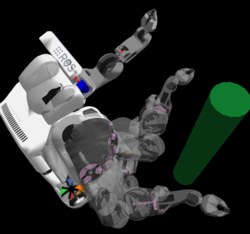cross-posted from willowgarage.com
Robot motion planning has traditionally been used to avoid collisions when moving a robot arm. Avoiding collisions is important, but many other desirable criteria are often ignored. For example, motions that minimize energy will let the robot extend its battery life. Smoother trajectories may cause less wear on motors and can be more aesthetically appealing. There may be even more useful criteria, like keeping a glass of water upright when moving it around.
 This summer, Mrinal Kalakrishnan from the Computational Learning and Motor Control Lab at USC worked on a new motion planner called STOMP, which stands for "Stochastic Trajectory Optimization for Motion Planning". This planner can plan paths for high-dimensional robotic systems that are collision-free, smooth, and can simultaneously satisfy task constraints, minimize energy consumption, or optimize other arbitrary criteria. STOMP is derived from gradient-free optimization and path integral reinforcement learning techniques (Policy Improvement with Path Integrals, Theodorou et al, 2010).
This summer, Mrinal Kalakrishnan from the Computational Learning and Motor Control Lab at USC worked on a new motion planner called STOMP, which stands for "Stochastic Trajectory Optimization for Motion Planning". This planner can plan paths for high-dimensional robotic systems that are collision-free, smooth, and can simultaneously satisfy task constraints, minimize energy consumption, or optimize other arbitrary criteria. STOMP is derived from gradient-free optimization and path integral reinforcement learning techniques (Policy Improvement with Path Integrals, Theodorou et al, 2010).
The accompanying video shows the STOMP planner being used to plan motions for the PR2 arm in simulation and a real-world setup. It shows the ability to plan motions in real-world environments, while optimizing constraints like holding the cans upright at all times. Ultimately, the utility of this motion planner is limited only by the creativity of the system designer, since it can plan trajectories that optimize any arbitrary criteria that may be important to achieve a given task.
For more information, please see Mrinal's slides below (download pdf), or checkout the code in the stomp_motion_planner package on ROS.org. This package builds on the various packages in the policy_learning stack, which was written in collaboration with Peter Pastor. You can also checkout Mrinal's work from last summer on the CHOMP motion planner.







Leave a comment